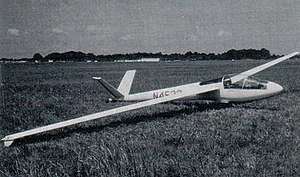Schreder HP-17
The Schreder HP-17 was an American mid-wing, V tailed, single seat, experimental glider designed by Richard Schreder to test a new airfoil section.[1]
| HP-17 | |
|---|---|
 | |
| The HP-17 | |
| Role | Glider |
| National origin | United States |
| Designer | Richard Schreder |
| Status | Sole example no longer on the US registry |
| Primary user | Richard Schreder |
| Number built | one |
Design and development
The HP-17 was designed to test a new airfoil section, the Wortmann FX 72 MS-150A. This airfoil is a high-lift, low drag section that Scheder thought would be a good sailplane design.[1]
The HP-17 is all-metal in construction, except for its foam wing ribs. The wing features water ballast carried inside the wing spar. The wing also has full-span flaps and spoilerons in place of ailerons.[1]
Operational history
The HP-17 was given its baptism of fire in the 1973 US Nationals when Schreder flew it in the FAI 15 Metre Class. The aircraft placed 38th and thus was not deemed a success. After the competition it was not used again and Schreder tuned his attention to the much more successful HP-18 instead.[1]
The HP-17 was retained by Schreder for many years, but in April 2011 it was no longer registered, not in the National Soaring Museum and its current whereabouts are unknown.[1][2][3]
Specifications (HP-17)
Data from Soaring[1]
General characteristics
- Crew: one
- Wingspan: 49 ft 3 in (15 m)
- Wing area: 113 sq ft (10.5 m2)
- Aspect ratio: 21.4
- Airfoil: Wortmann FX 72 MS-150A
- Empty weight: 500 lb (227 kg) including 200 lbs (90 kg) of water ballast
- Gross weight: 940 lb (426 kg)
Performance
- Maximum glide ratio: 40:1
- Rate of sink: 102 ft/min (0.52 m/s) at 40 mph (64 km/h)
- Wing loading: 8.3 lb/sq ft (41 kg/m2) with full water ballast
References
- Said, Bob: 1983 Sailplane Directory, Soaring Magazine, page 23. Soaring Society of America, November 1983. USPS 499-920
- Federal Aviation Administration (April 2011). "Make / Model Inquiry Results". Retrieved 16 April 2011.
- National Soaring Museum (2011). "Sailplanes in Our Collection". Archived from the original on 16 May 2011. Retrieved 26 February 2011.